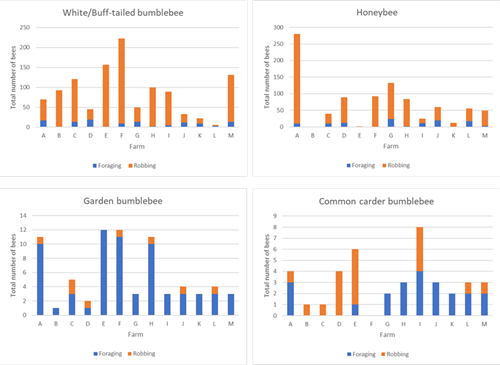The BEESPOKE project aims to reverse the decline of pollinators and increase crop pollination on farms in the North Sea Region. Currently the project partners are working to develop bespoke seed mixes and habitat management guidelines to support pollinators on a wide range of crop types.
In 2021, as part of this project, we carried out experiments to investigate how flower-rich areas around field bean crops affect crop pollination. We surveyed bees along transects and observed their behaviour, looking at whether they were foraging or robbing nectar from the bean flowers. Bees that forage enter the flower from the front, and in turn pollinate the flower when retrieving nectar. When they rob, they chew a hole at the back of the flower or use a hole made by another bee and they steal the nectar without pollinating the flower – a lot of people are unaware that bees even do this!
 Figure 1. Photo of a honeybee with its tongue out about to rob nectar from the back of a bean flower.
Figure 1. Photo of a honeybee with its tongue out about to rob nectar from the back of a bean flower.
Note: see how there is already a hole present at the back of the flower? (Credit: Thomas Van Loo)
Some bee species forage more than others, this is likely down to their tongue length, which we know is linked to their behaviour. Some flowers are shallow and are easily accessed by all bees, but longer-tubed flowers are more suited to long-tongued bees. Bee species with long tongues include the garden bumblebee, common carder bumblebee and most cuckoo bees, and short-tongued species include the white-tailed and buff-tailed bumblebee and the honeybee.
 Figure 2. The total number of different types of bees seen robbing and foraging across sites.
Figure 2. The total number of different types of bees seen robbing and foraging across sites.
So far, our results show that there were over 800 short-tongued bumblebee species counted across the farms, but less than 100 long-tongued bumblebees counted (Figure 2). The short-tongued bumblebees, specifically white and buff-tailed bumblebees and honeybees, carried out robbing behaviour much more frequently than foraging (Figure 3). There weren’t many cuckoo bumblebees present but we found that although cuckoos tend to have long tongues, they still rob most of the time. The long-tongued bumblebees – the garden bumblebee and common carder bumblebee – did forage more, but they were present in much lower numbers. Overall, we witnessed much more nectar robbing than foraging.

Figure 3. The total number of bees foraging and robbing at each farm sampled for four different
species of bee: the white/buff-tailed bumblebee and honeybee with shorter tongues, and the garden
and common carder bumblebee with longer tongues.
Other factors like temperature and cloud cover were also recorded to see if they influenced bee behaviour. Some trends were found – for instance, at the coldest temperature and when it was more overcast (above 80% cloud cover) there were a higher proportion of bees robbing. This is as expected, as when it’s colder and there is less sunshine, bees are slower and need to preserve their energy, so they opt to save energy by robbing flowers of their nectar. However, the trend becomes unclear as temperature increases and cloud cover decreases. Farm location and the presence of flower-rich habitats could be a factor that affects these trends.
Further exploration of our results and data collected by our BEESPOKE partners might provide more insight into the factors affecting bee behaviour. However, the initial results suggest that there is a much higher presence of short-tongued bees, which rob nectar more frequently than they forage and so may not pollinate the bean flowers as much.
The surrounding habitat will affect which species may be present in the area and how many. It might be possible to develop flower-rich habitat that specifically promotes longer-tongued bees, for example. This fits a key aim of the BEESPOKE project; by developing wildflower seed mixes made up of plants tailored to support specific pollinators and sowing these near to crops, it might be possible to improve crop pollination.